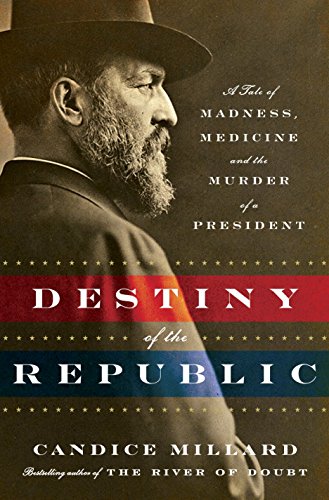- Features
- Description
- Similar Items
Binding:
HardcoverBrand:
Doubleday BooksEAN:
9780385526265Label:
DoubledayManufacturer:
DoubledayModel:
Size:
Warranty:
A Letter from Author Candice Millard
 At the heart of Destiny of the Republic is the story of the assassination of President James Garfield. What made me want to write this book, however, was not what I knew about President Garfield—that he had been shot by a deranged man in the summer of 1881—but all that I did not.
At the heart of Destiny of the Republic is the story of the assassination of President James Garfield. What made me want to write this book, however, was not what I knew about President Garfield—that he had been shot by a deranged man in the summer of 1881—but all that I did not. In everything I read, I am always looking for the thread of an idea, something that surprises me, and leaves me wanting to know more. To me, that’s the best part of being a writer—following an idea to see where it leads. Most of the time, after doing a little research, I quickly come to a dead end. One day four years ago, however, I found much more than I had ever expected.
While reading a biography of Alexander Graham Bell, I learned that Bell had tried to help save Garfield’s life after the President was shot. I wondered why a man as famous and powerful as Bell, who had invented the telephone just five years earlier, would abandon everything he was working on, put his life on hold, to help any man, even a President. The only way to answer that question, I realized, was to understand exactly what Bell had invented, and, more than that, to find out what kind of man Garfield had been.
After the assassination attempt, Bell devoted himself night and day to inventing something called an induction balance, a type of metal detector, to locate the bullet lodged in the President’s body. The induction balance that Bell used for the final time on Garfield is on display in the National Museum of American History, on the National Mall. What most people don’t know, however, is that the museum also has all of the versions of Bell’s induction balance, in various shapes and sizes, with hanging wires and unfinished edges, that he created while trying to perfect his invention. As I held these fragile instruments in my gloved hands, carefully examining their intricate workings, I could almost see Bell’s mind working, and his heart racing, as the President drew closer and closer to death.
Although, in the end, I would spend three years working on this book, it took only a few days of research to realize what Bell must have known—that President Garfield was not only a tragic figure, but one of the most extraordinary men ever elected President of the United States. A passionate abolitionist, Garfield was not only hailed a hero in the Civil War, but was a fierce champion of the rights of freed slaves. At the same time, he was a supremely gifted scholar who had become a university president at just 26 years of age, and, while in Congress, wrote an original proof of the Pythagorean Theorem.
With each diary entry and letter I read, each research trip I took, Garfield came more clearly and vividly to life. It was not until I visited the National Museum of Health and Medicine in Washington, D.C., however, that I began to understand the extent of the suffering that Garfield, and the nation with him, had endured. In its archives, in a large metal cabinet with long, deep drawers, the museum keeps the remains of two presidential assassins: John Wilkes Booth and Charles Guiteau, the man who shot Garfield. In the same cabinet, in a drawer just below Guiteau’s, lies a six-inch section of Garfield’s spine, a red pin inserted through a hole in the knobby, yellowed bone to show the path of Guiteau’s bullet. It is impossible to look at this heartbreaking collection without being struck by the fact that this story, now hardly remembered, was once a tragedy so wrenching that it transfixed and terrified an entire nation.
This book is my attempt to step back in time, to understand these men and this moment in history, and to tell a story that should never have been forgotten.






